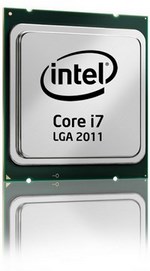Intel Core i7-4960X Ivy Bridge-E CPU Review
Introduction and Specifications
 This most recent metamorphosis of the PC hasn’t been kind to the high-end desktop processor segment. While the industry as a whole continues to focus on the steadily growing ultra-mobile market, and releases new products in rapid succession, there have only been two major flagship desktop processors released since the Intel Core i7-3960X hit the scene in late 2011—the slightly faster Intel Core i7-3970X and AMD’s limited edition FX-9590. And even then, AMD’s chip is most likely going to compete with Intel’s more mainstream quad-core parts. We’ll know exactly how it performs soon enough, when we complete our full evaluation of the FX-9590.
This most recent metamorphosis of the PC hasn’t been kind to the high-end desktop processor segment. While the industry as a whole continues to focus on the steadily growing ultra-mobile market, and releases new products in rapid succession, there have only been two major flagship desktop processors released since the Intel Core i7-3960X hit the scene in late 2011—the slightly faster Intel Core i7-3970X and AMD’s limited edition FX-9590. And even then, AMD’s chip is most likely going to compete with Intel’s more mainstream quad-core parts. We’ll know exactly how it performs soon enough, when we complete our full evaluation of the FX-9590.
Low-power parts that fit into small form factors may be all the rage right now, but today Intel advances the high-end desktop processor segment forward with the official unveiling of its Ivy Bridge-E microarchitecture and its associated products. The Core i7-4960X Extreme Edition processor is the flagship product in Intel’s initial line-up of Ivy Bridge-E based parts and it just so happens to be the processor we’ll be showing you here today. As its branding suggests, the Core i7-4960X is a generation update to the Core i7-3960X, 2011’s flagship desktop processor which was based on the Sandy Bridge-E microarchitecture.
Intel's Latest Flagship: The Core i7-4960X
|
| Six Core Processing: Runs 6 independent processor cores in one physical package Base Processor Frequency: 3.60 GHz (Turbo to 4GHz) Massive PCI Express Bandwidth: 40 lanes of PCIe supported through the processor Intel Turbo Boost Technology: Dynamically increases the processor frequency up to 3.90GHz when applications demand more performance. Speed when you need it, energy efficiency when you don’t. Intel Hyper-Threading Technology: 12 threads provide unprecedented processing capability for better multi-tasking and threaded applications. Do more with less wait time. Intel Smart Cache: Up to 15MB of shared cached allows faster access to your data by enabling dynamic and efficient allocation of the cache to match the needs of each core significantly reducing latency to frequently used data and improving performance. Overclocking Enabled: Fully unlocked multipliers for altering CPU and memory frequencies. Integrated Memory Controller: Supports 4 channels of DDR3-1866 memory with 1 DIMM per channel. Support for XMP memory. eXtreme Memory Profiles allow for simple performance tuning. |
|
For those of you not quite familiar with Intel’s codenames, Ivy Bridge was the codename used for a family of products built using Intel’s 22nm process technology. Ivy Bridge was a “Tick” in Intel’s CPU release cadence, which meant it was a somewhat mild revision of an existing microarchitecture—in this case Sandy Bridge—manufactured using a new process node, and with some new features thrown into the mix. It is not a totally new microarchitecture (that distinction came with Haswell), but a lower-power, better performing, and more economical to produce refinement of a previous product.

Ivy Bridge-E leverages those refinements and is a derivative of the original Ivy Bridge which launched last year. However, Ivy Bridge-E is also the more extreme variant of the microarchitecture that's meant to be a follow up to 2011's flagship Sandy Bridge-E lineup.
Above (in the spec table) we have a shot of an entire wafer of Ivy Bridge-E processors, along with the features and some specifications of the Core i7-4960X we'll be showing you here today. If you're a student of the desktop processor scene, you notice that most of the features are carryovers from previous-generation Intel processor offerings, but Ivy Bridge-E does have a few new tricks up its virtual sleeve as well. We’ll explain more and dive a little deeper on the pages ahead...







